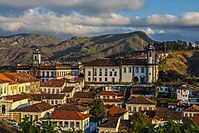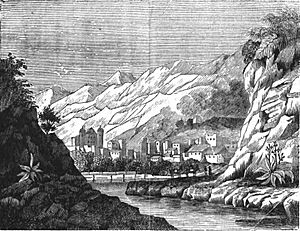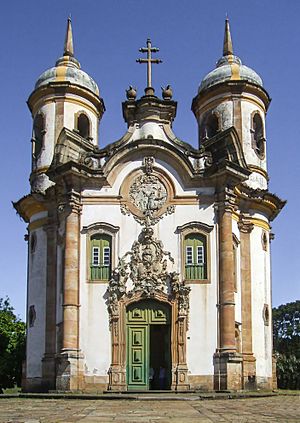Ouro Preto facts for kids
Quick facts for kids
Ouro Preto
|
|||
|---|---|---|---|
|
Municipality
|
|||
| Municipality of Ouro Preto | |||
|
|
|||
|
|||
| Motto(s):
Proetiosum aurum nigrum
(Precious black gold) |
|||

Location in Minas Gerais
|
|||
| Country | |||
| State | |||
| Region | Southeast | ||
| Intermediate Region | Belo Horizonte | ||
| Immediate Region | Santa Bárbara-Ouro Preto | ||
| Founded | 8 July 1711 | ||
| Area | |||
| • Total | 1,245.865 km2 (481.031 sq mi) | ||
| Elevation | 1,150 m (3,770 ft) | ||
| Population
(2020)
|
|||
| • Total | 74,558 | ||
| • Density | 59.8444/km2 (154.9962/sq mi) | ||
| Demonym(s) | ouro-pretano | ||
| Time zone | UTC−3 (BRT) | ||
| HDI (2010) | 0.741 – high | ||
| Official name: Historic Town of Ouro Preto | |||
| Type: | Cultural | ||
| Criteria: | i, iii | ||
| Designated: | 1980 (4th session) | ||
| Reference #: | 124 | ||
| Region: | South America | ||
Ouro Preto is a famous city in Brazil, located in the state of Minas Gerais. Its name means "Black Gold." It used to be called Vila Rica, which means "Rich Village." This city was once a big mining town during the time Brazil was a colony of Portugal.
Ouro Preto is known for its amazing old buildings. These buildings show a special style called Baroque colonial architecture. Because of its beautiful history and buildings, UNESCO named Ouro Preto a World Heritage Site. This means it's a very important place for everyone in the world to protect.
Ouro Preto was the capital of Minas Gerais from 1720 until 1897. Back then, it was one of the biggest cities in Latin America. In the 1730s, about 40,000 people lived there, and later, it grew to 80,000. To give you an idea, New York City had less than half that many people at the time! A lot of gold was sent to Portugal from Ouro Preto, and much of it was used to decorate the city's churches.
Other historic cities in Minas Gerais that are also worth visiting include São João del-Rei, Diamantina, Mariana, Tiradentes, Congonhas and Sabará.
Contents
History of Ouro Preto
Ouro Preto was founded in the late 1600s. It was first named Vila Rica, meaning "Rich Village." This area became the center of Brazil's gold rush in the 1700s, when Portugal ruled the country. Gold was first found here around 1695-1696.
In 1711, several small towns joined together to form a new municipality called Vila Rica. On May 20, 1823, Vila Rica became a city and was renamed Ouro Preto. The name "Black Gold" comes from the gold found in the city, which was often covered with a layer of iron oxide, making it look black.
The city center still has many old Portuguese colonial buildings. You won't see many modern buildings there. Any new buildings must match the city's historic look. Churches from the 1700s and 1800s are decorated with gold and amazing sculptures by an artist named Aleijadinho. This makes Ouro Preto a popular place for tourists.
The huge amount of gold found in the 1700s made Ouro Preto a very rich city. Many smart people from Europe came to live there. Art and new ideas grew, leading to a special style called "Barroco Mineiro." You can see this style in the buildings and in the works of artists like Aleijadinho and painters like Manoel da Costa Ataíde. At one point, Vila Rica was the largest city in Brazil, with 100,000 people.
In 1789, Ouro Preto was the starting point of the Inconfidência Mineira. This was a plan to gain independence from Portugal, but it did not succeed. The main leader, Joaquim José da Silva Xavier, known as Tiradentes, was hanged. This was meant to scare anyone else who wanted to start a revolution.
In 1876, the Escola de Minas (Mines School) was opened. This school helped Brazil make many important discoveries in mining. Ouro Preto was the capital of Minas Gerais from 1720 until 1897. The government needed more space, so the capital moved to the new city of Belo Horizonte.
Geography and Climate
Key Facts About Ouro Preto
- Population: About 70,227 people lived here in 2010.
- Area: The city covers about 1,245 square kilometers.
- Temperature: Temperatures usually range from 6 to 28 degrees Celsius. In June and July, it can get as cold as -2 degrees Celsius.
- Elevation: The city is about 1,116 meters above sea level. The highest point is Pico de Itacolomi, which is 1,722 meters high.
- Districts: Ouro Preto has twelve districts, including Amarantina, Cachoeira do Campo, and Lavras Novas.
- Rivers: Several rivers start here, like the Velhas and Piracicaba rivers.
Where is Ouro Preto?
Ouro Preto is connected by winding roads to major highways. Here are some distances to other big cities:
- Belo Horizonte: 100 km
- Rio de Janeiro: 475 km
- São Paulo: 675 km
- Brasília: 840 km
The cities bordering Ouro Preto are:
- North: Itabirito and Santa Bárbara
- South: Ouro Branco, Catas Altas da Noruega, Piranga and Itaverava
- East: Mariana
- West: Belo Vale and Congonhas
Weather in Ouro Preto
Ouro Preto is about 1,179 meters above sea level. It has a subtropical highland climate. This means it has warm and wet summers, and mild, dry winters. Sometimes, there is frost in June and July. There was even a report of snow in the city in 1843!
| Climate data for Ouro Preto, Brazil | |||||||||||||
|---|---|---|---|---|---|---|---|---|---|---|---|---|---|
| Month | Jan | Feb | Mar | Apr | May | Jun | Jul | Aug | Sep | Oct | Nov | Dec | Year |
| Mean daily maximum °C (°F) | 26.0 (78.8) |
26.1 (79.0) |
25.3 (77.5) |
24.0 (75.2) |
22.5 (72.5) |
21.6 (70.9) |
21.3 (70.3) |
23.0 (73.4) |
24.0 (75.2) |
24.2 (75.6) |
24.5 (76.1) |
24.6 (76.3) |
23.9 (75.1) |
| Mean daily minimum °C (°F) | 15.6 (60.1) |
15.5 (59.9) |
14.0 (57.2) |
13.4 (56.1) |
10.9 (51.6) |
9.1 (48.4) |
8.3 (46.9) |
9.5 (49.1) |
12.0 (53.6) |
13.7 (56.7) |
14.7 (58.5) |
15.2 (59.4) |
12.7 (54.8) |
| Average precipitation mm (inches) | 283 (11.1) |
208 (8.2) |
175 (6.9) |
82 (3.2) |
29 (1.1) |
17 (0.7) |
15 (0.6) |
24 (0.9) |
57 (2.2) |
115 (4.5) |
223 (8.8) |
324 (12.8) |
1,552 (61) |
| Source: Climatedata.org. | |||||||||||||
Economy and Resources
Ouro Preto's economy relies a lot on tourism today. But it also has important metal and mining industries. Big companies like Novelis (an aluminum factory) and Vale S.A. are located here.
The main ways people make money in Ouro Preto are through tourism, factories that change raw materials, and mining. The city has rich deposits of minerals like iron, bauxite, manganese, talc, and marble.
Some special minerals found in Ouro Preto include gold, hematite, dolomite, tourmaline, pyrite, muscovite, and topaz. A very special stone called imperial topaz is only found in Ouro Preto!
You can find many cool souvenirs made from Soapstone in the city's shops and street fairs. These are popular with tourists. You can also buy jewelry made from local precious and semi-precious gemstones, like hematite.
University Life
Ouro Preto is also a university town with a lively student community. The Universidade Federal de Ouro Preto (Federal University of Ouro Preto or UFOP) has about 10,000 students. Many students live in shared houses called repúblicas. These are a bit like fraternity houses in North America. There are 66 repúblicas owned by the university and about 250 private ones.
The repúblicas system in Ouro Preto is special in Brazil. It's similar to traditions from the Portuguese University of Coimbra, where the idea started. Each república has its own history. In some, new students (called "bixos") go through a "batalha" (battle) period before they are fully accepted. The older students must all agree to let a new student join.
The Museu Mineralógico da Escola de Minas (Mineralogy Museum) is a great place to visit. It belongs to the UFOP's School of Mining, which opened in 1876. The museum is in the historic center and has a huge collection of minerals. You can see precious and semi-precious gemstones and large crystals. Security is very strict because the items are so valuable.
Fun Things to Do in Ouro Preto
Ouro Preto is a top place for tourists. People love its well-preserved colonial look, with beautiful Baroque buildings and old cobblestone streets.
Churches to Explore
The city has many churches, famous for their religious art and Baroque style. Some of the most well-known are:
- Nossa Senhora do Carmo (Our Lady of Mount Carmel)
- São Francisco de Assis (St. Francis of Assisi)
- Nossa Senhora da Conceiçao (Immaculate Conception)
- Capela do Padre Faria (Father Faria's Chapel)
- Nossa Senhora das Mercês (Our Lady of Mercy)
- Nossa Senhora do Pilar (Our Lady of the Pillar)
- Nossa Senhora do Rosário (Our Lady of the Rosary)
Interesting Museums
- Museu da Inconfidência: Located in the old municipal palace, this museum tells the story of the Inconfidencia independence movement.
- Museu do Oratório (Oratory Museum): Next to the Nossa Senhora do Carmo church, it shows religious art.
- Museu de Ciência e Técnica (Museum of Science and Technology): Inside the Ouro Preto School of Mines building, it has a great collection of minerals.
- Casa Dos Contos: A historical museum.
- Museu do Aleijadinho: In the Antônio Dias plaza, this historical museum has a collection of works by the famous artist Aleijadinho.
Old Gold Mines
You can take tours of several old gold mines in the city. One famous one is the Mina do Chico Rei. Another well-known mine is the Mina da Passagem. In the early 1800s, Portugal gave England the right to use this mine for 100 years to pay off debts. It's the largest mine open to the public in the world! About 10% of the Serra do Gandarela National Park is also within the municipality.
Carnival Fun
The street carnival in Ouro Preto brings thousands of people every year. Carnival blocks are a traditional type of parade. Bands play music as groups of people in costumes follow them through the town. The block Zé Pereira dos Lacaios, started in 1867, is the oldest one still active in Brazil! There are also parades with samba schools. The street party is also celebrated in nearby towns like Mariana.
More About Ouro Preto
Ouro Preto was used as a filming location for the comedy movie Moon over Parador (1988), starring Richard Dreyfuss and Sonia Braga. Mining is a very important industry in Brazil, being the sixth largest in the country.
Images for kids
See also
 In Spanish: Ouro Preto para niños
In Spanish: Ouro Preto para niños




















